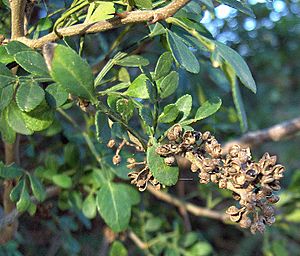Zanthoxylum fagara facts for kids
Quick facts for kids Zanthoxylum fagara |
|
|---|---|
 |
|
| Conservation status | |
| Scientific classification | |
| Genus: |
Zanthoxylum
|
| Species: |
fagara
|
| Synonyms | |
|
Schinus fagara L. |
|
Zanthoxylum fagara, also known as wild lime, is a type of flowering plant. Even though it's called "wild lime," it's not a true lime fruit. It belongs to the same plant family as citrus fruits, called Rutaceae. This plant grows naturally in places like southern Florida and Texas in the United States. You can also find it in Mexico, Central America, the Caribbean, and parts of South America, all the way down to Paraguay. People call it by many names, including lime prickly-ash, wild lime, colima, uña de gato, and corriosa.
Contents
What is Wild Lime?
Wild lime is usually a spreading shrub or a small tree. It can grow up to 7 m (23 ft) (about 23 feet) tall. Its main stem, called a trunk, is often rough and has gray bark. The trunk can grow to be about 0.25 m (0.82 ft) (about 10 inches) wide.
Leaves and Spines
The branches of the wild lime tree have hooked spines. Its leaves are about 5 cm (2.0 in) (2 inches) long and are called "pinnate." This means they have smaller leaflets arranged along a central stem, like a feather. Both the leaves and the bark of the tree can be crushed. They have a bitter taste and can be used as a condiment, which is something added to food for flavor. The whole tree often smells a bit like citrus fruits.
Where it Grows
Wild lime plants are very good at handling dry weather. This is called having a high drought tolerance. They grow best when they get a lot of sunshine. However, they can also survive as a smaller plant growing under taller trees. This is known as an understory shrub.
Importance for Wildlife
This plant is very important for local wildlife. It provides food and a safe place for animals to hide. The leaves are especially important for the larvae (young forms) of many butterflies. For example, the giant swallowtail butterfly (Papilio cresphontes) lays its eggs on wild lime leaves. The caterpillars then eat the leaves as they grow.
How People Use Wild Lime
In the past, people have used the powdered bark and leaves of the wild lime plant. They used it as a spice because it has a smell similar to real limes.
See also
 In Spanish: Limoncillo o rabo de lagarto para niños
In Spanish: Limoncillo o rabo de lagarto para niños


